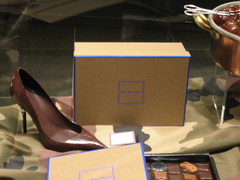"Connie?" piped Ona's voice from my speakerphone. "Uhhh, did you call the meat store?"
"Ooooh, yes!" I picked up the receiver. Tiffany's head swiveled around. I recognized that expression. The "what is she doing this time??" expression.
Which was precisely what I was thinking twenty-four hours later as I left Joe Scalise's and Sons butcher and deli, clutching a volleyball-sized package. It was more like the size (and shape) of a human head, but I preferred not to think of it that way. What was I doing, exactly? There was something vaguely unholy about purchasing something so big at the butcher's for a mere two dollars. Actually, it really was unholy. The day before, Scalise's had called to inform me that my order of caul fat had come in. Caul fat sits upon the kidneys of a pig. It is definitely not kosher. Once rendered, it is known as leaf lard, and it is widely considered among most culinary aficionados, when combined with butter, as the best form of shortening to produce tender, flaky pie crusts.
I had read Elmer Grossman's quest for leaf lard in Saveur magazine several months earlier, and mentally shelved it amongst my ideas for culinary experimentation. Since the weather has started to cool off, I had begun spend more time in my galley of a kitchen baking. My recent fascination with raw vs. pasteurized dairy led me to produce pastry doughs with raw butter. Although the raw butter was extremely flavorful, its crumbly texture was unacceptable for the pate feuillete (puff pastry) I was trying to perfect (no malleability whatsoever). Its crumbly character however would make a good pate brisee (pie crust) for my tarte tatin. After the second attempt, it produced a flaky, sweet and delicious, albeit temperamental crust. However, the raw butter was too temperamental, expensive and difficult to procure for use on a regular basis. When Anne, who has never failed to produce delicious tarts and pastries, began to tinker with using rendered duck fat in her piecrust, the Saveur article came to mind. Mr. Grossman, after several obstacles, obtained his own caul fat, and rendered it to produce leaf lard. Inspired by Anne's creativity, I managed to get ahold of the aforementioned article, and called my local butcher, Scalise's, on a whim. Despite Mr. Grossman's difficulties, Scalise's managed to fill my order on the same day.
After brunching on homemade beignets, goat cheese and mimosas (breakfast of champions!), I delved into my newly purchased (for 50 cents! from a yard sale!) copy of Larousse Gastronomique, and cross-referenced it with the Saveur article. Both recipes were essentially the same. They seemed fairly simple - you cut the fat up into dice-sized 1-inch cubes, place it in a heavy pot on low heat, with a quarter cup of water per pound. The water, I supposed, would prevent the solids in the fat from burning (and eventually going rancid, not to mention the carcinogens) as it renders.
Feeling brave, I unwrapped the package on my counter. There it lay, in compressed milky pink folds, approximately four pounds of caul fat. I took a deep breath, unsheathed my 8-inch Global chef's knife, and sank it through the middle. I couldn't help but think of Bill the Butcher's line from Gangs of New York. "The flesh that is closest to that of a man is that of a pig," or something like that. The resemblance in both size and shape of this flesh colored mass to a human head did not ease my trepidation. But the ease and precision in which my treasured blade cleaved through the layers turned my initial distaste into fascination. Cutting the fat though, into cubes, was a whole other story. Caul fat is layers and layers of spiderweb like netting, and as I cut it, the slices that were to become cubes fell apart in stringy shreds. So much for dice-sized cubes. It didn't really matter though, since these bits of fat were going to be melted down anyways. (I supposed if you really want cubes, you could freeze the fat briefly so it holds up.) I chopped up the remaining fat into my 3.5 quart All-Clad Master Chef pot, and set it on low, with one cup of water. Fifteen minutes later, a happy gray mass of fat, juices and oils was bubbling away on my stove. To keep the fat from becoming a tangled and matted lump when I stirred, I lifted the longest "strings" from the pot with a wooden spoon and trimmed them with a pair of kitchen shears. After about two hours, the rendering was complete. I drained the solids, which were now cracklins, through a wire mesh strainer and a cheesecloth. Then, I filtered the strained oil through a coffee filter and poured it into a loaf pan lined with wax paper. After chilling it overnight, I cut the now snowy-white hardened fat (my heart is pounding away as I type) into half-cup sticks, and wrapped them with wax paper.
Now I'm left with about two cups of cracklins (to be used in biscuits, cornbread, etc.), an All-Clad pot crusted with pork fat solids, and a house with the unmistakable stench of carnitas. But I have 8 sticks of lard... let the pie making begin!













0 Comments:
Post a Comment
<< Home